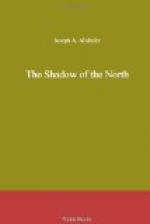The warriors built the fire anew and cooked their breakfasts. They had venison and hominy of three kinds according to the corn of which it was made, Onaogaant or the white corn, Ticne or the red corn, and Hagowa or the white flint corn. They also had bear meat and dried beans. So their breakfast was abundant, and they ate with the appetite of warriors who had done mighty deeds.
Daganoweda and Willet, as became great men, sat together on a log and were served by a warrior who took honor from the task. Black Rifle sat alone a little distance away. He would have been welcome in the company of the Mohawk chief and the hunter, but, brooding and solitary in mind, he wished to be alone and they knew and respected his wish. Daganoweda glanced at him more than once as he remained in silence, and always there was pity in his looks. And there was admiration too, because Black Rifle was a great warrior. The woods held none greater.
When Robert awoke it was well on toward noon and he sprang up, refreshed and strong.
“You’ve had quite a nap, Robert,” said Willet, who had not slept at all, “but some of the soldiers are still sleeping, and Tayoga has just gone down to the spring to bathe his face.”
“Which I also will do,” said Robert.
“And when you come back food will be ready for you.”
Robert found Tayoga at the spring, flexing his muscles, and taking short steps back and forth. “It was a great run you made,” said the white youth, “and it saved us. There’s no stiffness, I hope?”
“There was a little, Dagaeoga, but I have worked it out of my body. Now all my muscles are as they were. I am ready to make another and equal run.”
“It’s not needed, and for that I’m thankful. St. Luc will not come back, nor will Tandakora, I think, linger in the woods, hoping for a shot. He knows that the Mohawk skirmishers will be too vigilant.”
As they went back to the fire for their food they heard a droning song and the regular beat of feet. Some of the Mohawks were dancing the Buffalo Dance, a dance named after an animal never found in their country, but which they knew well. It was a tribute to the vast energy and daring of the nations of the Hodenosaunee that they should range in such remote regions as Kentucky and Tennessee and hunt the buffalo with the Cherokees, who came up from the south.
They called the dance Dageyagooanno, and it was always danced by men only. One warrior beat upon the drum, ganojoo, and another used gusdawasa or the rattle made of the shell of a squash. A dozen warriors danced, and players and dancers alike sang. It was a most singular dance and Robert, as he ate and drank, watched it with curious interest.




